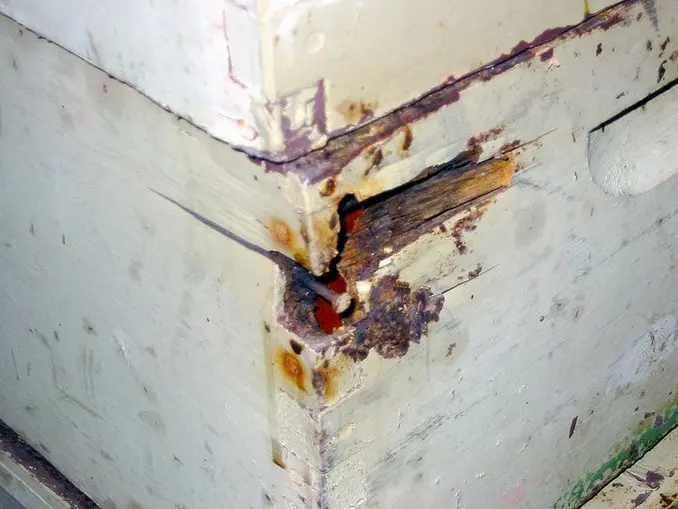Year 1 December - Winter Musings 🖊️

-Those rotten corners can be a hive’s winter demise in Wyoming.
The brutal subzero weather and relentless hurricane winds have finally eased up. It’s been months since I last checked the beeyard, and I decided it was high time. Lo and behold, the hives are still kicking. A stroke of luck that I stopped by, or they might not have made it through the winter. Sometimes, rotten luck isn’t entirely bad!
Towards the end of last summer, I did a bit of spring cleaning, culling all boxes with rotten corners and downsizing my hive count. The survivors boasted tight corners, a crucial shield against Wyoming’s harsh winter winds. A corner, especially up high and facing the prevailing wind, spells doom for a hive during our extended winter.
However, the wooden ware has deteriorated faster than I anticipated. Each hive now sports at least one corner wide open to the wind. Those rotten corners were cunningly concealed by a fresh coat of paint at summer’s end.
I lost a robust hive to these very circumstances last season. Despite my attempts to patch up an open corner, it disintegrated over the winter, and the relentless wind claimed the bees.
What’s the Plan?
I wasn’t prepared for this snag. My worst-case scenario involved setting up hives that cows or wild game might have knocked over or retrieving a lid that had taken flight. I didn’t anticipate this issue.
So, armed with a sharp stick and some latex gloves from the truck, I played bee carpenter and stuffed them into the open corners. It’s a makeshift fix, to say the least. I fear it’s a temporary solution, as the bright colors, any fluttering, and perhaps even differences in odor might attract curious critters that’ll investigate by pulling them out.
More frequent visits to the yard are now on the agenda.
‘Winter thinking’ about future equipment has shot up my priority list, and a gradual transition into alternative equipment is no longer a luxury.
That’s a Wrap
Wood
I snagged most of this wooden ware back in 1996 for an experimental yard and a few more in 2000 for small cell tests. So, they’re somewhere between 10 and 14 years old. These boxes have lived a long life, but come next spring, it’s time to bid them farewell. I’ll be replacing them.
Paint
And this marks the end of my love affair with painting bee equipment. I slapped on four coats of paint on this equipment. While the paint offered some protection, it concealed and exacerbated the dry rot now endangering my bees’ survival.
Paint traps the moisture generated inside the hive. For it to work effectively, the inside of the hive should be painted to keep interior hive moisture out of the wood. But I’m not a fan of paint inside the hive. It wouldn’t hold up well, a hive tool would quickly dismantle it, and it might introduce contamination.
As a seasoned commercial beekeeper, I’ve painted thousands of covers, boxes, and bottoms, only to watch most of them go through the same aging process. Most are gone in less than seven years. A rare few stand the test of time. I don’t know what makes the difference, but it’s certainly not the paint. I won’t miss painting one bit.
Alternatives
Wood
In my climate, I haven’t stumbled upon a suitable alternative to wood. It’s natural, and the bees are accustomed to it. If I were situated in a different climate and not a migratory beekeeper, I might opt for another material.
Paint
So, what’s the alternative? I’m leaning towards paraffin dipping—a quick, cost-effective, reliable, and more durable solution. Paraffin dipping is akin to deep-frying. You heat a sizable amount of paraffin in a large tank, submerge bee equipment for 10 minutes to boil out moisture, and replace it with paraffin. It’s an excellent solution if you have the equipment and a safe space for a good fry.
However, with a modest amount of bee equipment and a residential backyard, traditional paraffin dipping is out of the question.
If I can’t devise another paraffin dipping method or find a good alternative, I’ll leave them unpainted.
Pondering Thoughts
Much of beekeeping is like that, isn’t it? A beekeeper can craft the perfect plans, gather all the right tools, and brace for any conceivable circumstance. Yet, when the beekeeper and the bees meet, it’s a whole new ball game.
Winter is the time for sorting through equipment, stacking it according to anticipated spring needs. Now, I’m no novice at this—I’ve been keeping bees in this climate for decades. Yet, without fail, I discover that the items I need most are invariably at the bottom or towards the back of the stack!
That’s how most beekeepers end up with a mishmash of ill-fitting equipment. They’re often compelled to take action, and it’s usually not on their own terms. It’s not what they planned or would opt to do in different circumstances. But it’s the best solution at the time.
Commercial beekeepers are particularly vulnerable, often having little time or cash for anything less than expedient solutions.
Anyway, just bee natural. ✨
-Cheers, D 🐝🤠
